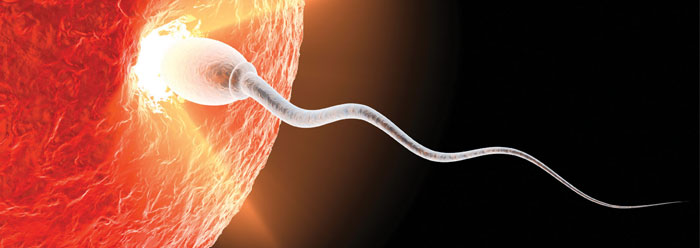A new life is started the moment a human sperm cell unites with a human egg. Sounds simple, doesn't it? A person can decide for himself, but he will need to follow along very closely to catch all of the details and carefully piece them together, just as he would follow a skillful mystery.
The voyage of a single sperm cell from production to fertilization begins with rapidly dividing cells within a testis called spermatogonia. These divisions are crucial to place in the sperm cell 23 chromosomes--exactly half the number within normal human cells. When the sperm fuses with the egg, which also has undergone divisions within the mother's ovary, the full complement of 46 chromosomes will be present. However, cellular mechanisms allow slight variations in the information contained on certain portions of the chromosomes to be shuffled during the divisions. This feature ensures that each sperm and egg carry the correct information to make a normal human, but each is different as to the exact traits that will be expressed by the new person. The genetic combination in the newly-fertilized egg will be totally unlike that of any person who has ever lived before or ever will be born afterwards--truly resulting in an absolutely unique individual.
The sperm starts out as a round, immobile cell. It is surrounded by other cells in the testis called Sertoli cells, which function only to transform the sperm cell into a lean swimming machine that is capable of carrying its genetic cargo to the egg. Sertoli cells transfer nutrients to the developing sperm from the blood stream, since at this point in development the sperm must not be in contact with blood. Large amounts of cellular fluid within the sperm, called cytoplasm, are also removed by the Sertoli cells, and internal cellular components are precisely rearranged so that the sperm begins to take on the shape of a long and slender cell with a whip-like tail. An important structure, the "acrosomal body," that will eventually develop highly erosive enzymes--able to dissolve the membranes around other cells--is made by Sertoli cells at the newly-developed head of the sperm and sealed in a protective coat.
A high concentration of the male hormone testosterone in the testes is essential to make normal sperm. Where does it come from? Far from the testes, the brain's hypothalamus will release "gonadotropin-releasing hormone," which stimulates the pituitary gland to release "follicle-stimulating hormone" and "lutenizing hormone." These make their way via the blood stream to the testes. Lutenizing hormone stimulates other cells in the testes called "Leydig cells" to manufacture prodigious amounts of testosterone. Follicle-stimulating hormone now causes the Sertoli cells to produce "androgen-binding proteins" that will bind the testosterone produced in Leydig cells and concentrate it inside, where it will have its effect on the developing sperm. As the testosterone level increases, it also circulates throughout the body. When the correct concentration of testosterone (along with a concentration of the hormone "inhibin," which is made in Sertoli cells) circulates back to the hypothalamus and pituitary gland of the brain, these structures are signaled to stop secreting their hormones. Without this stimulus, Leydig cells decrease production of testosterone until the circulating concentration drops to a level that will trigger the cycle to start all over again--keeping it in perfect balance.
Recall how the sperm are being kept from contact with the blood. They are locked behind very tight junctions between Sertoli cells that make a collective configuration called the "blood-testis barrier." Why? A male does not begin producing sperm until puberty, and the markers on the new sperm cells have not been programmed into his immune system. The male's immune system is programmed to recognize specific combinations of protein markers on the outside of his cells as belonging to his own body--but that programming takes place while he is still in his mother's womb. Were it not for this barrier, sperm cells would be recognized as foreign cells by the male's own immune system and destroyed, rendering the male sterile. If the junction between Sertoli cells is broken, such as what happens when the testes become inflamed during an infection with Mumps virus, antibodies can make their way from the blood stream past the barrier and destroy the developing sperm.
Sperm placed inside a woman find themselves in a very hostile environment, with features that either destroy microscopic entities or block entrance into her body. The normal vaginal environment is very acidic (pH 3.5), which suppresses dangerous bacterial overgrowth but also kills sperm. Fluids produced by the male seminal vesicles are part of the semen and temporarily neutralize (pH 7.5) the acid. The neutral environment then activates the sperm. A thick sticky mucus plug also blocks the small cervical opening into the uterus. However, another product of semen called prostaglandins causes this mucus to become more liquid-like. Not coincidentally, the mucus may also have been made even thinner by an estrogen surge in the woman around the time she ovulates an egg. Now sperm are able to swim through the mucus into the uterus--all the while converting substances in the mucus to energy.
The uterus is protected by millions of cells of the woman's immune system that kill microscopic invaders. This obstacle is overcome by substances in the semen that have local, but very broad spectrum, immunosuppressive effects that blunt her immune response in the area of the semen. This may leave the woman vulnerable to infection, but another substance in semen, "seminalplasmin," can kill bacteria and has a protective effect. Normally, coordinated movements of mobile hair-like projections called cilia on some cells lining the uterus, coupled with slight rhythmic contractions of the uterus, produce a defensive fluid current that pushes things out of the uterus--which would be impossible for the sperm to swim against. Yet another product of semen after making contact with the uterus causes these coordinated actions of the woman's uterus to reverse direction and pull the semen and sperm up into the uterus and assist the sperm on its journey.
Surprisingly, freshly-deposited sperm are incapable of fertilizing an egg. Many features of the sperm are changed by substances that are made within the female reproductive tract. Remember the sperm's acrosomal body discussed earlier? One of the most important changes, known as "capacitation," is when uterine secretions remove glycoproteins from the protective coat of the acrosome. This allows the erosive enzymes from many sperm (after contacting the egg) to break down a protective coat of cells around the egg and expose its cell membrane so that yet another sperm can make its way to the egg for fertilization. This elaborate coordination between female secretions and male sperm is protective for the male, since without the protective coat around the acrosome, high concentrations of sperm in a man's body could destroy the function of his reproductive organs if the erosive enzymes were released prematurely.
The acrosome is coated with the protein "bindin" that will adhere only to special species-specific receptors on the egg, ensuring that only sperm from the same species can fertilize the egg. In less than a second after the sperm's contact, many channels in the egg's membrane open, allowing an inrush of positively-charged sodium ions. This creates an electrical charge across the outer surface of the egg that blocks other sperm from fertilizing it and inactivates all remaining "bindin" receptors on the egg. Concurrently, substances just inside the egg’s cell membrane are released that bind up water molecules and cause the membrane to swell up to permanently detach any remaining sperm on the outside. These blocks prevent entrance of genetic material from any other sperm into the egg, which would be fatal to baby and may also be to mother. Once united, tube-like structures in the egg rapidly build and then project from the egg and pull the nucleus of the sperm into the egg--the first cell of a new person.
Amazing? Actually, the detail could go far beyond this simple description. As seen, the level of coordinated interaction to get any viable offspring exceeds the cellular level, extends past the reproductive system, pulls in the neurologic, hormonal, and circulatory systems, and demands substances that are produced independently by the male to modify the actions of the female body or the materials made by her--and vice versa. Evolutionary literature is rife with speculative stories about the origination of these processes, but devoid of any real scientific evidence to explain them. The only viable explanation is that these processes were placed by the Lord Jesus in the first parents, Adam and Eve, fully functional right from the beginning.
* Dr. Guliuzza is ICR's National Representative.
Cite this article: Guliuzza, R. 2009. Made in His Image: Human Reproduction. Acts & Facts. 38 (1): 14.



















